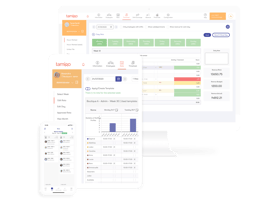Great internal communication is key to the success of any business. Without it, staff are left unsure of their tasks, targets or even when they're due in.
That’s a challenge for restaurant businesses, which rely on happy, productive employees to provide stellar customer service.
Restaurant groups and chains need to ensure a couple of things:
- Staff are getting clear communication from their managers on matters of day-to-day operations.
- Staff are receiving all the important policies and news that head office (primarily HR or payroll managers) are sending out.
So how can multi-site restaurant business achieve this? Read on for 3 quick tips.
1. Centralise updates in one place
Let’s say your restaurant group is updating your workplace hygiene policy. It’s something tamigo’s customers had to do frequently over the course of the pandemic.
How will your managers communicate this update?
They might announce it during a staff meeting or pin a printout to a noticeboard. It’s a disjointed approach. Can you be sure that all your locations’ employees (FOH and BOH) have seen it?
Centralising these types of updates in one place is the solution.
Enter tamigo Chat, an instant messaging tool for hospitality.
Alongside regular one-to-one messaging, Chat lets admins post no-reply announcements. These can go to multiple employees, specific roles (e.g. waiters) or departments.
In practice, this gives your restaurant managers direct lines of digital communication to their team — the muddle of social media messages, texts, calls and emails.
2. Implement staff meetings AND one-on-ones
The weekly staff meeting is a time-honoured tradition for every restaurant. Managers can set the focus for the upcoming week and answer staff’s questions (sometimes with food included, if there’s surplus inventory to use up!)
In a workplace that’s split between front of house and back of house, it’s also an opportunity to bring those teams together and build common ground.
But staff meetings have their limitations. They’re group discussions after all, focused on the overall performance of the restaurant.
To check in with employees on an individual level, think about instigating one-on-ones in all your locations.
This is 30 minutes every month where a manager sits down with each employee to gauge how they’re doing. Is everything good in the team? Are they wondering about when to book holidays? Maybe they’d like to start training up for a team lead role?
Employees feel more listened to and valued. And that equals a happier, more engaged workforce.

3. Increase transparency around shifts and salaries
Restaurant shift plans are ever-changing. Your managers need to make quick decisions based on evolving sales. That could mean calling in extra cover or asking someone to work overtime on the day. Plus, there’s shift swaps and holidays too.
For staff, this dynamism makes it difficult to keep track of their schedules. And more importantly, to trust that their hours have been recorded properly, and that their payslips are correct.
Opting to implement a workforce management gives employees more transparency over their hours.
In the tamigo app, the schedule is always up to date. Whatever changes are made, it’s updated instantly in real-time. If a someone’s upcoming shifts are affected, they’ll get a notification.
That’s looking forward.
Looking back, staff can also check the stored record of their worked hours. And because tamigo integrates with your payroll solution, those timesheets are imported right into your payroll software — ensuring compliance and guarding against the data entry errors that come with spreadsheets or pen and paper.
So if an employee has a question about last month’s hours, it’s no longer a question of phoning your group’s HR manager. They can just check it in tamigo.
Restaurant groups across Europe use tamigo to ensure effective team communication company-wide, but also so much more.
Our cloud-based, all-in-one workforce management solution includes the tools they need to maintain operational efficiency — from absence management through to payroll exports.
To learn more, head to our dedicated restaurant industry page.





